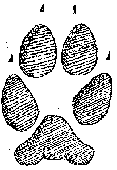
Identifying carnivore tracks
Banff National Park
Carnivore tracks
By taking basic safety precautions for carnivores such as wolves, cougars, and coyotes, we can minimize the risks to human safety and ensure the carnivores in Banff National Park remain wild. Wildness in this case means that these animals retain their natural fear of people.
Characteristics of coyote tracks
Coyote:
Medium-sized dog. Thick, bushy tail. Greyish-brown in colour.
-
- Four toe pads
- Claws show
- Elongated, symmetrical footprint
- Hind print slightly smaller
- Average print 6.4 cm long
- Smaller than a wolf track
Characteristics of wolf tracks
Wolf:
Built like a large German Shepherd, with longer legs. Colour can vary from white to black.
-
- Four toe pads
- Claws show or form drag marks
- Elongated, symmetrical footprint
- Triangular heel pad
- Often travel in trenches through deep snow
- Hind print slightly smaller
- Tracks 10 - 12 cm long
- Larger than coyote track
Characteristics of cougar tracks
Cougar:
The largest Canadian cat is the mountain lion or cougar. Although rarely seen, signs indicate that there is a small but healthy population of approximately 7-10 animals in the park.
-
- Four toe pads form a semi-circle
- Claws do not show
- Elongated asymmetrical foot print
- Three lobes on heel pad
- Slow deliberate steps
- Hind print slightly smaller
- Tracks are wider than longer
- Double-register when walking
- Tail drags in deep snow
Identifying carnivore tracks | Wildlife safety | Wildlife watching and photography
Related links
- Date modified :


